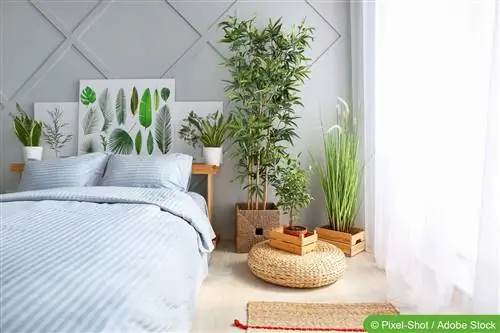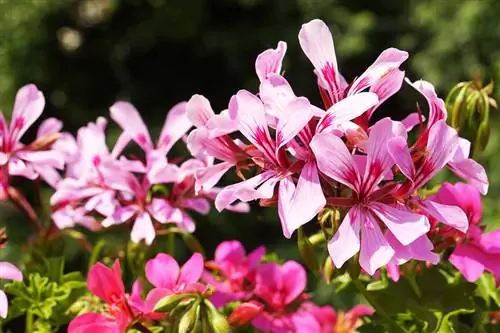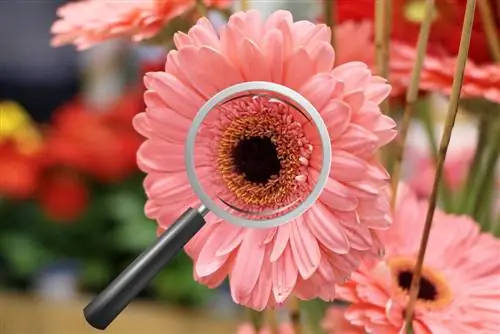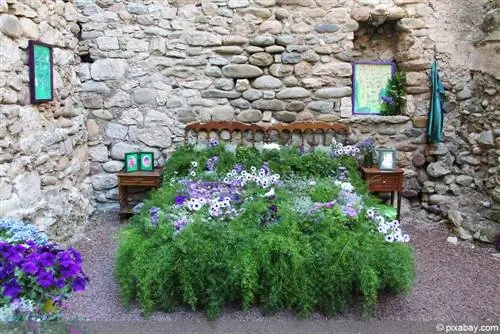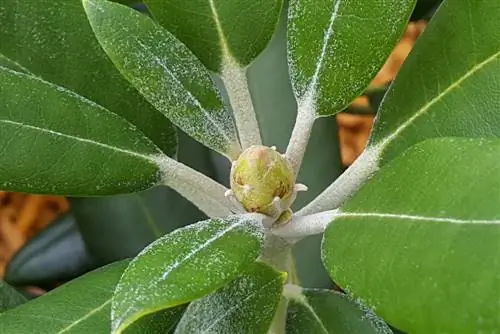- Author admin [email protected].
- Public 2023-12-17 03:39.
- Last modified 2025-01-24 12:45.
They improve the air and bring fresh greenery into the sleeping environment: houseplants such as birch fig, spider plant and leaf flag. Caution is particularly advised for allergy sufferers, especially if plants produce essential oils in addition to oxygen. Green plants without flowers are particularly recommended.
Green your bedroom
The number and size of plants should depend on the size of the room. Every plant needs its level of oxygen. If you are crammed into too small a space, the supply can be affected. Therefore: less is more. There is no need to turn the bedroom into a small jungle. Properly accentuated, plants contribute to the feel-good atmosphere of the room without appearing overloaded.
Locations for Bedroom Plants
Every plant in the bedroom needs light and therefore a bright and sunny location. That's why it has to be set up so that it gets enough daylight, even if it's attractive to brighten up dark corners of the room with fresh greenery. Suitable locations are, for example, near the windowsill or opposite the bedroom window. However, too much direct sunlight can have harmful effects and, for example, lead to burns on the leaves.
Caring for Bedroom Plants
Bedroom Plants rely on a continuous supply of oxygen. Therefore, sufficient ventilation must be ensured. However, without exposing a plant to direct drafts. If you don't want to buy ready-made potted plants but want to plant them yourself, you should pay particular attention to the quality of the potting soil. If you neglect this, there is always the risk of bringing pests and pathogens from the ground into the bedroom. In addition, the potting soil should be checked regularly for excess moisture, as mold spores can form here, which can be harmful to he alth. Alternatively, granules can be used instead of soil. However, the following applies to both: Renew regularly. Then not only does the plant thrive best, the risk to he alth is also kept as low as possible.
Top 3 recommended plants
Birch figs (Ficus Benjamini)
The birch fig, also known as Ficus Benjamini, is a classic for the bedroom. Due to the strong green leaf color, the plant is without a doubt a visual upgrade. In addition to a bright and sunny location, the birch fig also needs the right temperatures, ideally between 20 and 25 ° C, at least 15. It gets by with a relatively small amount of water and should be kept moist but not overwatered due to waterlogging. Ficus Benjamini also needs appropriate humidity. To support it, it helps to regularly spray the plant with water. Liquid fertilizer should be used every three weeks in summer and every six weeks in winter. Once a location has been chosen, it should be retained if possible.
Green lilies (Chlorophytum comosum)
The spider plant is a welcome resident not only in the bedroom, but also in other rooms. Especially due to the fact that it is quite undemanding and does not require any extensive care. It is often used as an ampel plant.
- 10 °C room temperature is the absolute minimum for the plant to grow and thrive properly.
- It is watered very sparingly and can go without watering for a weekend or a short vacation.
- Keeping the potting soil slightly moist is optimal.
- The spider plant is also popular thanks to its cheap purchase and easy propagation, as the plant quickly produces offshoots on its own.
- Poted in good potting soil, it is enough to add a little liquid fertilizer every now and then to support their growth.
- Since the spider plant quickly cultivates new shoots in the form of children, it is very easy to propagate.
To do this, you can, for example, cut off individual children, place them in water until they have developed their own roots and then plant them in their own pot. It can happen that the plant is attacked by pests such as aphids. This is easy to spot because a sticky layer forms on the leaves. Other pests such as mealybugs are visible as they cover the plant with small webs. One way to combat this is to spray with soapy water after carefully rinsing with water.
Leaf Flag (Spathiphyllum)
For anyone who wants to bring some floral splendor into the bedroom, leaf flags are just the thing. The flowers mainly appear in spring or summer. The following also applies to this plant:
- A bright location without direct sunlight is best, otherwise the leaves will be damaged.
- It is watered regularly, but the top layer of soil is allowed to dry out a little in between.
- Room temperature should be at least 13°C to allow proper growth.
- In addition, the room air must not be too dry.
- To provide the plant with enough humidity, a lower bowl filled with water and stones is suitable.
- It should also be sprayed regularly with water. This also avoids infestation by pests such as spider mites.
In spring, the leaf flag must be repotted into a larger pot until the leaves have reached their maximum size of 15 to 20 cm. Leaf flags should be supplied with some liquid fertilizer every two weeks. You can propagate the plant yourself by division. To do this, the plant is carefully removed from the pot and sections with at least three leaves are separated, which are then ideally planted in a compost/leaf soil and sand mixture. They are carefully tapped in. Freshly divided plants should not receive any fertilizer for three months.
Other plants that are good to keep in the bedroom include various palm plants, such as the yucca palm. Rubber and dragon trees, cacti or arched hemp are also suitable. If you are unsure, you should seek advice from a specialist retailer. Then there's nothing wrong with 'greening' the bedchamber.
What you need to know about bedroom plants in brief
The prejudice that green plants in the bedroom are unhe althy still persists. It's the other way around: During the day, with the help of sunlight, they convert carbon dioxide into plant-specific substances and release oxygen into the environment. At night, however, they need oxygen themselves and release unwanted carbon dioxide. However, the amount is so small that damage to he alth can be completely ruled out. Finally, two insider tips among bedroom plants: Their striking growth and shiny green leaves make the Zamioculcas a trendy plant! The African beauty is extremely easy to care for. It thrives in any bright place and can even tolerate drought at times.

